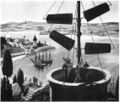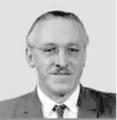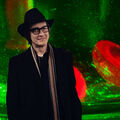Template:Selected anniversaries/March 2: Difference between revisions
No edit summary |
No edit summary |
||
| Line 4: | Line 4: | ||
File:Leonardo_da_Vinci_in_flight.jpg|link=Leonardo da Vinci|1478: Artist, inventor, and crime-fighter [[Leonardo da Vinci]] writes a letter to [[Johannes Engel (nonfiction)|Johannes Engel]], suggesting the need for an almanac of [[crimes against astronomical constants]]. | File:Leonardo_da_Vinci_in_flight.jpg|link=Leonardo da Vinci|1478: Artist, inventor, and crime-fighter [[Leonardo da Vinci]] writes a letter to [[Johannes Engel (nonfiction)|Johannes Engel]], suggesting the need for an almanac of [[crimes against astronomical constants]]. | ||
||1729 | ||1729: Francesco Bianchini dies ... astronomer and philosopher. | ||
||Pietro Paoli | ||1759: Pietro Paoli born ... mathematician. | ||
File:Signaling by Napoleonic semaphore line.jpg|link=Semaphore telegraph (nonfiction)|1791: Long-distance communication speeds up with the unveiling of a [[Semaphore telegraph (nonfiction)|semaphore telegraph machine]] in Paris. | File:Signaling by Napoleonic semaphore line.jpg|link=Semaphore telegraph (nonfiction)|1791: Long-distance communication speeds up with the unveiling of a [[Semaphore telegraph (nonfiction)|semaphore telegraph machine]] in Paris. | ||
||1825 | ||1825: Roberto Cofresí, one of the last successful Caribbean pirates, is defeated in combat and captured by authorities. | ||
||Karl Gottfried Hagen | ||1829: Karl Gottfried Hagen dies ... chemist. | ||
||1830 | ||1830: Samuel Thomas von Sömmerring dies ... physician, anatomist, and anthropologist. | ||
||Julius Weingarten | ||1836: Julius Weingarten born ... mathematician. He made some important contributions to the differential geometry of surfaces, such as the Weingarten equations. Pic. | ||
||Jean Alexander Heinrich Clapier de Colongue | ||1838: Jean Alexander Heinrich Clapier de Colongue born ... marine engineer and founder of a theory of magnetic deviation for magnetic compasses, living and working in Imperial Russia. Pic. | ||
||Viktor von Lang | ||1838: Viktor von Lang born ... chemist. He is counted among the pioneers and founders of crystal physics. | ||
||1840 | ||1840: Heinrich Wilhelm Matthias Olbers dies ... physician and astronomer. | ||
||George Chandler Whipple | ||1866: George Chandler Whipple born ... civil engineer and an expert in the field of sanitary microbiology. His career extended from 1889 to 1924 and he is best known as a co-founder of the Harvard School of Public Health. Whipple published some of the most important books in the early history of public health and applied microbiology. Pic. | ||
||1880 | ||1878: Wander Johannes de Haas (2 March 1878 – 26 April 1960) was a Dutch physicist and mathematician. He is best known for the Shubnikov–de Haas effect, the de Haas–van Alphen effect and the Einstein–de Haas effect. Pic: https://ro.wikipedia.org/wiki/Wander_Johannes_de_Haas | ||
||1880: John Benjamin Macneill dies ... engineer. | |||
||1880: Alfred James Lotka born ... mathematician, physical chemist, and statistician, famous for his work in population dynamics and energetics. An American biophysicist, Lotka is best known for his proposal of the predator–prey model, developed simultaneously but independently of Vito Volterra. The Lotka–Volterra model is still the basis of many models used in the analysis of population dynamics in ecology. Pic. | ||1880: Alfred James Lotka born ... mathematician, physical chemist, and statistician, famous for his work in population dynamics and energetics. An American biophysicist, Lotka is best known for his proposal of the predator–prey model, developed simultaneously but independently of Vito Volterra. The Lotka–Volterra model is still the basis of many models used in the analysis of population dynamics in ecology. Pic. | ||
| Line 50: | Line 52: | ||
||1927: Kurt Leichtweiss born ... mathematician specializing in convex and differential geometry. Pic. | ||1927: Kurt Leichtweiss born ... mathematician specializing in convex and differential geometry. Pic. | ||
||1949 | ||1949: Captain James Gallagher lands his B-50 Superfortress Lucky Lady II in Fort Worth, Texas after completing the first non-stop around-the-world airplane flight in 94 hours and one minute. | ||
||1962 | ||1962: Charles Jean de la Vallée-Poussin dies ... mathematician and academic. | ||
||Henrietta Bolt | ||Henrietta Bolt | ||
| Line 58: | Line 60: | ||
File:Pioneer 10 construction.jpg|link=Pioneer 10 (nonfiction)|1972: The ''[[Pioneer 10 (nonfiction)|Pioneer 10]]'' space probe is launched from Cape Canaveral, Florida with a mission to explore the outer planets. | File:Pioneer 10 construction.jpg|link=Pioneer 10 (nonfiction)|1972: The ''[[Pioneer 10 (nonfiction)|Pioneer 10]]'' space probe is launched from Cape Canaveral, Florida with a mission to explore the outer planets. | ||
||1995 | ||1995: Researchers at Fermilab announce the discovery of the top quark. | ||
File:Jordan Carson Mark.gif|link=J. Carson Mark (nonfiction)|1997: Mathematician [[J. Carson Mark (nonfiction)|Jordan Carson Mark]] dies. He oversaw the development of nuclear weapons for the US military, including the hydrogen bomb in the 1950s. | File:Jordan Carson Mark.gif|link=J. Carson Mark (nonfiction)|1997: Mathematician [[J. Carson Mark (nonfiction)|Jordan Carson Mark]] dies. He oversaw the development of nuclear weapons for the US military, including the hydrogen bomb in the 1950s. | ||
||1998 | ||1998: Data sent from the Galileo spacecraft indicates that Jupiter's moon Europa has a liquid ocean under a thick crust of ice. | ||
File:Niles Cartouchian interrogates Fugitive Rubies.jpg|link=Niles Cartouchian|2017: Famed gem detective [[Niles Cartouchian]] captures supervillain [[Fugitive Rubies]]. | File:Niles Cartouchian interrogates Fugitive Rubies.jpg|link=Niles Cartouchian|2017: Famed gem detective [[Niles Cartouchian]] captures supervillain [[Fugitive Rubies]]. | ||
||2017 | ||2017: The elements Moscovium, Tennessine, and Oganesson were officially added to the periodic table at a conference in Moscow, Russia | ||
</gallery> | </gallery> | ||
Revision as of 15:44, 27 August 2018
1453: Doctor, astronomer, and astrologer Johannes Engel born. He will publish numerous almanacs, planetary tables, and calendars.
1478: Artist, inventor, and crime-fighter Leonardo da Vinci writes a letter to Johannes Engel, suggesting the need for an almanac of crimes against astronomical constants.
1791: Long-distance communication speeds up with the unveiling of a semaphore telegraph machine in Paris.
1911: Astronomer, physicist, and mathematician Arthur Eddington builds new type of scrying engine which detects and prevents crimes against mathematical constants.
1972: The Pioneer 10 space probe is launched from Cape Canaveral, Florida with a mission to explore the outer planets.
1997: Mathematician Jordan Carson Mark dies. He oversaw the development of nuclear weapons for the US military, including the hydrogen bomb in the 1950s.
2017: Famed gem detective Niles Cartouchian captures supervillain Fugitive Rubies.






